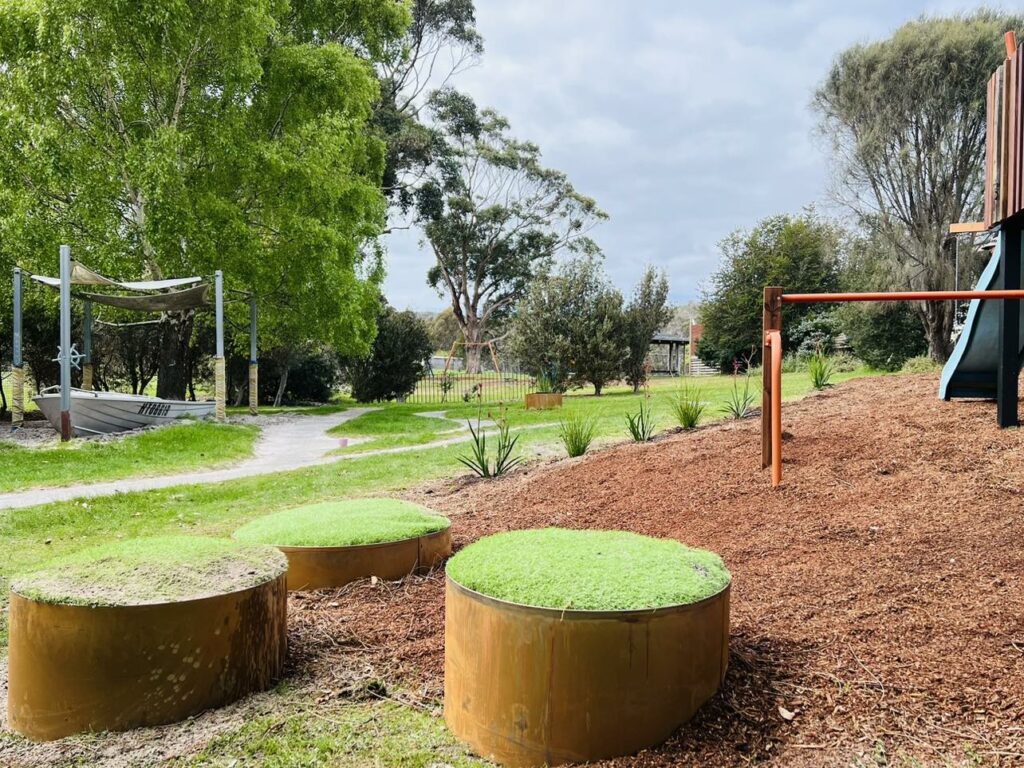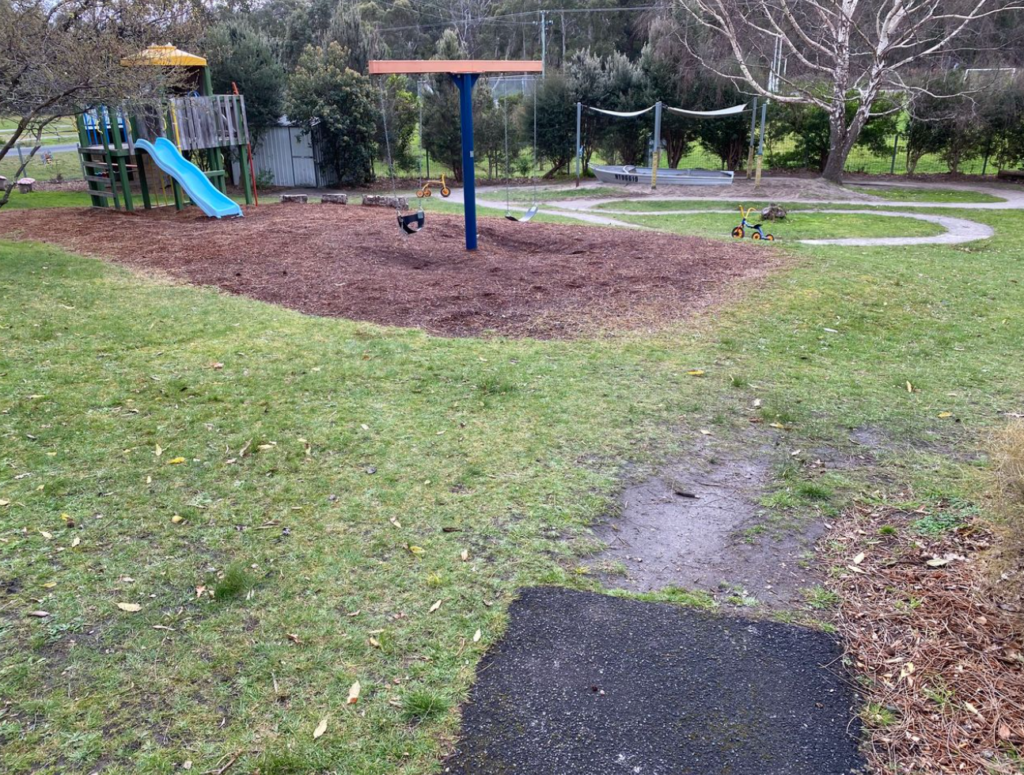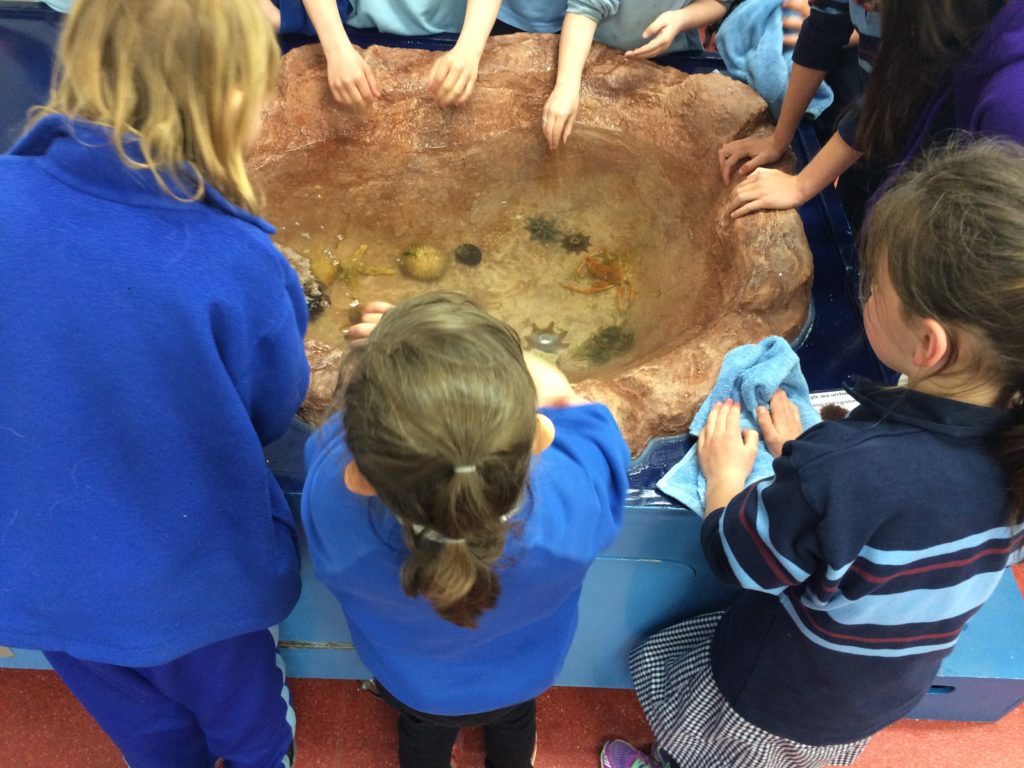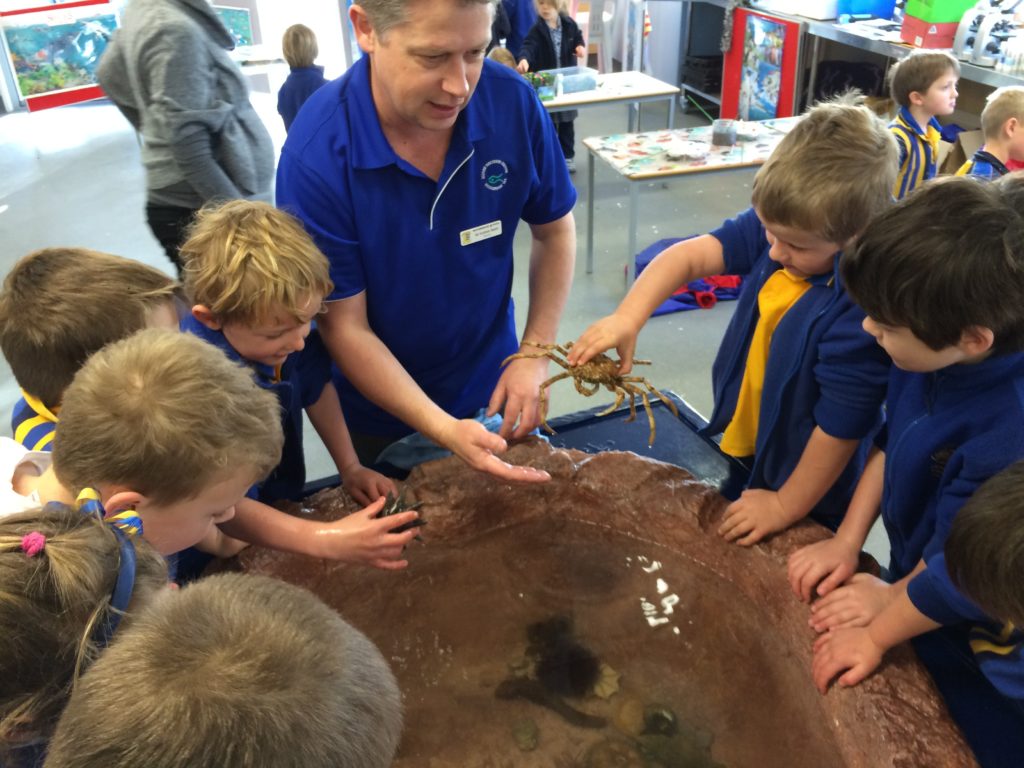Foundation for Rural & Regional Renewal (FRRR)
In 2020 the Bruny Island District School Parents & Friends committee identified the need to upgrade the ‘Billabong Playground’, which caters for children up to five and their families.
Working with a local landscaper, the plan was to retain the swings, cubby house, bike path and sandpit and add an above ground timber tunnel with climbing grips over it, a small princess castle and artificial grass covered seats/jumping pods. They also intended to create a safe water play area incorporating a cauldron that fills with water and can be released via a plug. This flows into a wetland area beyond the playground fence. All this would be surrounded by plants and surfaces that stimulate sensory play.
While there were some changes along the way, the main installation and repair took place in early October 2022 and was ready for use mid-October. The work was undertaken by a local contractor, with volunteers adding plants and the artificial grass seats, as well as some timber sleeper steps in mid-October 2022.
The project was supported by a $10,000 SRC grant, thanks to the support of the Bertalli Family Foundation. However, local businesses were also asked to contribute to the project, which meant they could also install a timber shelter. The Playground is now fully functional with the 65+ students from the school and wider community being able to access it.
But the project resulted in far more than just a great play space for the children. It has strengthened the connections between the school and local businesses and the community more broadly. Additionally, the project gave a small group of volunteers the confidence to know that they can achieve great outcomes to improve their community. They displayed courage and aspiration, values that have been included in Bruny School’s values and it’s fantastic for the students to see the results they can bring, not only individuals but the entire community and future generations.
The small town of Abergowrie, on the lands of the Warrgamay people, is a thriving farming community located 40 km north-west of the township of Ingham in north QLD. The small but vibrant Abergowrie State School is one of 100 Queensland schools with fewer than 20 students and plays an important role as a hub for the broader community, with facilities used as a disaster recovery centre, polling place, community library, along with hosting preschool playgroups, social events and community activities.
With strong ties to local history, the school community regularly looks for ways to foster new partnerships, strengthen existing relationships and promote community connections. Encouraging cultural diversity and awareness is a priority for the school community, understanding that promoting an open and welcoming learning environment strengthens wellbeing, both within the school grounds and more broadly across the community. To achieve this, integrating spaces and experiences within the school that reflect cultural connection is vital, to both students, families and others.
To create an inclusive and culturally appropriate space, the Abergowrie Primary P&C Association (APP&C) applied for funds through the Strengthening Rural Communities program to deepen cultural understanding and community engagement through the building of a landscaped Yarning Circle. The volunteer run APP&C plays an important role promoting parent participation and encouraging collaboration between parents, students and the local community to achieve the best educational outcomes and learning experiences for the children in a fun and safe environment.
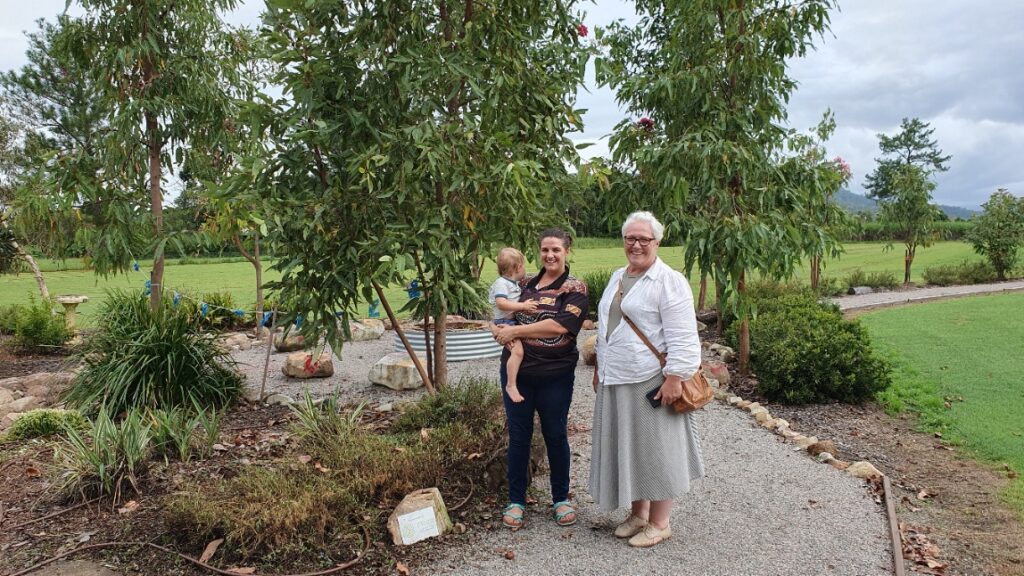
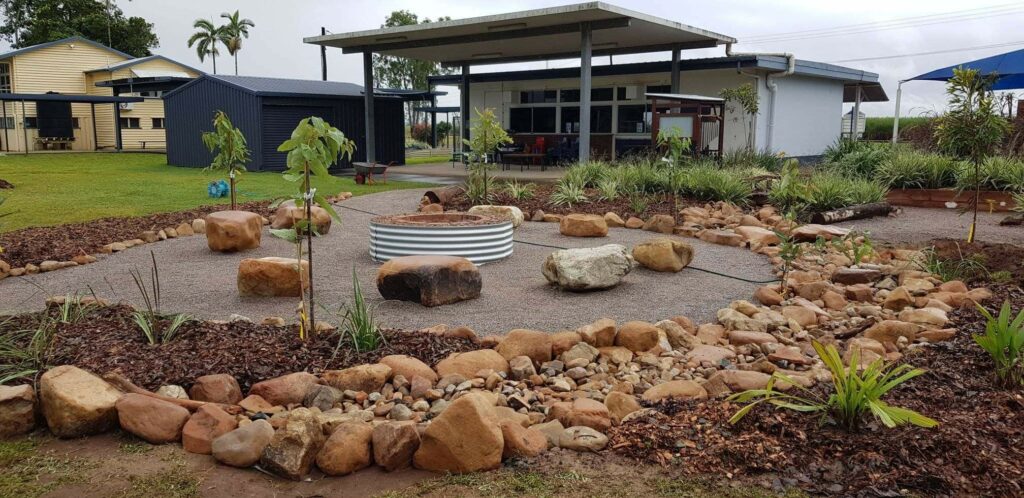

The Warrgamay people are the traditional custodians of the land that Abergowrie State School resides on and the APP&C Association wanted the Yarning Circle to reflect their culture and spirit. Yarning circles have been used by Australia’s First Nations peoples for centuries and are a place of honesty, trust, respect and safety where every person in attendance is equal. They’re used to teach new generations about the past and engage them with culture for the future.
To ensure the project was culturally respectful, the school community engaged two Aboriginal Elders of the Warrgamay people to help deliver the project. The Elders offered to help shape the design of the Yarning Circle and provided guidance on ways the Yarning Circle could be used by the school and the community. They also helped plan cultural aspects into the design of the Yarning Circle, including paintings and artwork. Lead by the Elders, the students were involved in this part of the project providing a cultural learning experience and encouraging them to taking ownership of the Yarning Circle creation.
True to the spirit of collaboration, the primary school also drew on the close ties with nearby St Teresa Secondary College, which promotes rich and diverse cultural learning programs for young people with an Aboriginal and Torres Straight Island background. St Teresa College provided cultural knowledge and expertise to the project, and the space continues to be used for shared experiences between the schools.
The $10,000 grant, which was funded by The Yulgilbar Foundation, paid for the materials and services of the landscaper and builders. With the project costing more than the requested amount, the APP&C negotiated ways to reduce the overall cost, which involved local donations of materials and a community working bee. With many hands on-deck, the project was completed over a weekend. Those helping included students, school parents, grandparents, teaching, cleaning and ground person staff, Warrgamay Elders and community members. The APP&C shared with the FRRR team that it was a fun, rewarding weekend that connected all of those involved.
The completed Yarning Circle is set among gardens with native trees providing shade and a beautiful, calm setting. When termites were discovered on the site, impacting the materials that could be used as seating around the fire pit, challenges were viewed as opportunities with timber logs swapped for large natural rocks, fitting in with the Australian bush setting seamlessly. A fire pit was built in the centre of the Yarning Circle using kiln-fired bricks, with a lid that’s placed over the pit when it’s not in use to create a functional surface.
By building this space, the APP&C hoped to encourage confidence and resilience in students and foster an attachment to culture and their surrounding environment.
Since completion, the Yarning Circle area has brought people together for the official opening smoking ceremony, dances, informal gatherings, and has been incorporated into student learning. Abergowrie Primary School P&C continues to encourage the community to be involved in social activities and events where the Yarning Circle plays an integral role. Through the creation of this inclusive, culturally appropriate space, the broader community can continue to be involved in community conversations in a safe and accepting environment to encourage connections and ties to community, place and self, as the comments below attest.
“Through this project, the community created a space in the school that has brought people of all walks of life together. During construction, there were discussions of absolute excitement between all involved, and in particular between the school parents and teaching staff and the Warrgamay Elders. These talks were full of energy and openness on how this space will be the platform that will bring cultures together and make us all a stronger group of people. I speak as a parent of three girls who attend Abergowrie State School when I say that I am filled with joy to be working with members of the Warrgamay people and knowing that my children will be a part of this collaboration. The Warrgamay people have an abundance of passion for sharing their cultural knowledge and being part of our school’s journey. This I am very proud to be a part of.”
“We are very grateful for the Aboriginal Elders’ involvement and excitement towards this project and feel that this could truly become a place of significance in the Abergowrie community.”
“For small schools like ours, it is very challenging for our P&C to make a significant contribution to the learning experience of our children. Grants like this make it possible for our parent community to really contribute to our kids’ journey through school.”
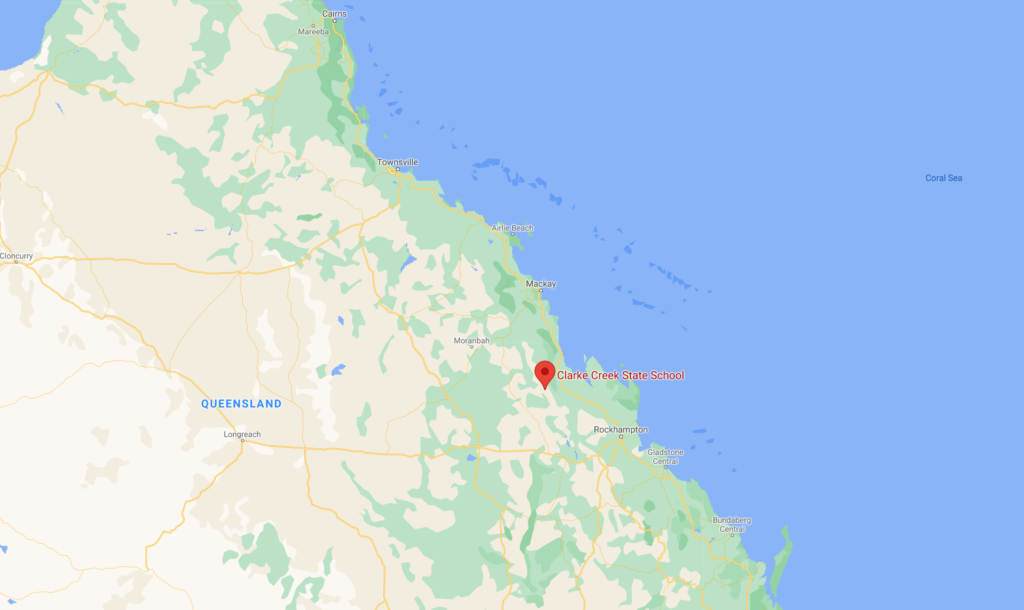
In the remote locality of Clarke Creek in Queensland’s Isaac Region, a community of 320 people have been doing it tough in recent years. In March 2017 Tropical Cyclone Debbie and flash flooding devastated the area, and then came the drought.
People from Clarke Creek mostly own or work on cattle stations, many run by extended and intergenerational family groups. School-aged children in the area were exposed to many impacts of Cyclone Debbie – from damage to community and family infrastructure, livestock and pet animal losses, to financial strain putting pressure on their families.
A problem-solving school
The saving grace of this community is the Clarke Creek State School (CCSS), which, in the absence of a township, serves as the community hub. It caters to the needs of 17 students from Kinder to Year 6, extends support to siblings, parents and extended families of those students, and provides a meeting place for all groups in the area, including the P&C Association.
The Clarke Creek P&C Association knew it was critical to support children through all this, and that school can help facilitate healing by providing the sense of normality that’s needed after a disaster. Since residents of Clarke Creek had to travel up to 230kms to access health and professional services, the P&C Association knew that, for help to be constructive, it would need to be brought into Clarke Creek.
The school had previously gained the services of a chaplain directly though the National Schools Chaplaincy Program, however the school could only afford one visit per fortnight without outside funding. By late 2018, it was clear that there was a need for ongoing disaster support for families. With so many pressures affecting the ability to fundraise locally in the tiny community, the P&C Association applied to FRRR’s In a Good Place program. A grant of $10,000 funded by CCI Giving essentially doubled the chaplain’s visits to weekly from July 2019 until March 2020, when the Department of Education funding applications opened.
Chaplaincy support proves vital
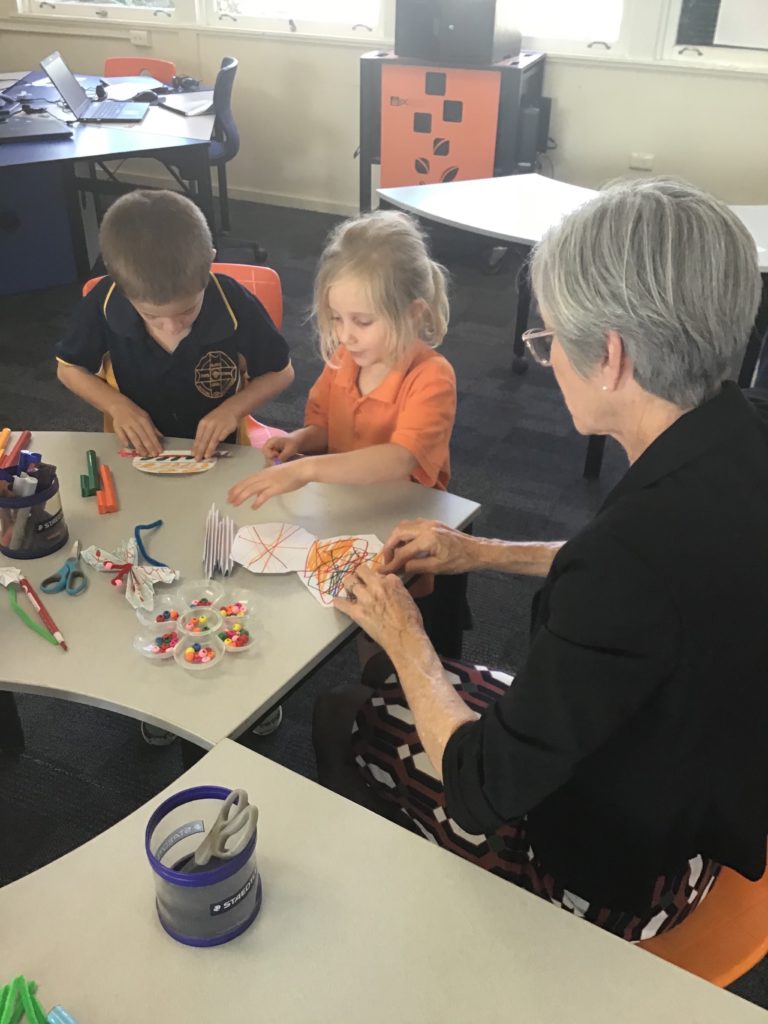
In small schools, the school chaplain is often the welfare provider, and plays a key part of the school support team.
The chaplaincy support at CCSS started shortly after the school and community were devastated by cyclone Debbie, and proved to be highly valuable to students, staff and the broader community, in their ongoing recovery and general mental health and wellbeing. The chaplain attends the school one day each week, working with the children in groups and one on one sessions. She provides emotional support and fosters leadership and kindness in the classroom, playground, and at school events.
“Chappy’, as she is fondly nicknamed, has been imparting those crucial life skills to the children and helping them to deal with the many challenges unique to living in a remote community in an isolated context.
It was a crucial time to bring in extra support, and the P&C Association don’t make light of the importance of Chappy’s role. Throughout COVID-19, the chaplain helped children deal with changes to their learning and became a central figure of stability for parents and the wider community.
The CCSS Principal notes how important the chaplain is in helping students transition through their education.
“I think the older students love the way she makes sure they all know that they have a voice and that someone cares enough to make the time to listen. She helped prepare older students for boarding school, and taught younger ones to be engaged in learning and practising kindness.”
The chaplain attends school and community events, and works with other schools in the cluster, thus creating support networks in the broader communities and creating an inclusive atmosphere and strengthened sense of community. But it’s the flow-on effects from the children’s gains that have the greatest power, as described in the final report:
“Our greatest achievement has been just stabilising our community. Oddly, this was really achieved through the children coming home from school with this positive energy and outlook from their time with Chappy, rather than working direct with parents and community. When the parents knew the kids would be ok and had someone strong to lean on, it was like a weight lifted and the school became the place of ‘normalcy and support’. Things picked up from there.
“In a small school and community, we have to stick together. Chappy has fostered this sense of belonging and caring in our children and it emanates from there.”
Merrigum Primary School is a rural Victorian primary school with a small number of staff and students. The school is committed to building school capacity to provide students with educational opportunities through enhanced, personalised learning.
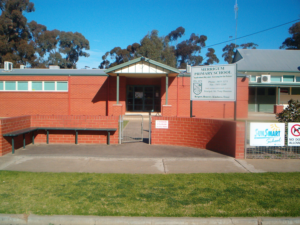
Many Merrigum Primary Students come from diverse backgrounds and some require additional learning support – something that the school community strives to provide them with. One of the areas where the school wanted to offer more support was music activities and education for the pupils.
In partnership with Merrigum Primary School, The Song Room, an organisation that delivers integrated music and art lessons in school delivered a six-month music program to students from Foundation to Year 6, working alongside their classroom teachers. The program was possible with thanks to a $7,500 REAPing Rewards grant.
Students greatly enjoyed the program and looked forward to their music lessons. Caitlyn Trotter, who led the program for students, told FRRR that the children responded well to all the activities.
“By the end of the lesson, they understood the basic (musical) terms. The children enjoyed being able to work together as a class and loved that they got to play an instrument as part of a song. This was always thoroughly enjoyed.”
This was reflected in the feedback from teachers, Belinda and Judi who reported that “The sessions were very well planned and built sequentially week after week to offer students the opportunity to develop skills at a targeted pace. The students had a lot of fun, and even some of the more reluctant musos were looking forward to class by the end of it.”
As part of the program, The Song Room also facilitated professional development lessons for the teachers, so that the music program could continue well beyond the formal end of The Song Room’s time at the school. Teachers were given lessons plans, games and instructions on how to facilitate music classes in a way that supports the current curriculum. Merrigum Primary School now also has ongoing access to more than 1,000 hours of online video resources from The Song Room to assist with planning and developing arts curriculum for students in the future.
More than 580 students in regional and rural Tasmania have reaped the rewards of a $5,000 grant received by the Woodbridge School and Marine Discovery Centre (MDC).
Woodbridge School & Marine Discovery Centre began operations in 1979 as a federally funded marine education facility. Its mission is to challenge students of all ages to learn, discover and care for the marine environment through diverse sea and shore based programs. Since 1997, it has been managed as part of Woodbridge School. All programs focus on practical, hands on experience which are linked directly to the curriculum. The organisation employs teaching staff (through Woodbridge School), a Ship Master, Education Facility Attendant and Admin Assistant.

Throughout the period February to September 2015, MDC teacher Andrew Walsh travelled more than 2100 km taking the roadshow to five primary schools and one secondary school, enabling 583 students to engage in hands-on marine science activities that are linked to the Australian Science Curriculum.The MDC was wanting to upgrade and expand the outreach of their travel program. They contacted a number of rural Tasmanian schools who had not participated either in the travel program or visited the centre before, to gauge their interest in having the MDC marine discovery incursion at those schools, and the response was positive. The REAPing Rewards grant, funded by the Ian Potter Foundation, covered travel expenses of the MDC’s teacher, the purchase of resources such as ice boxes and aerators to safely transport live touch tank animals, and a flat screen display to support the classroom presentation. The funds were also used to maintain the (sometimes leaky!) purpose-built touch tank constructed by MDC for travelling that contains a circulating filter pump and chiller.
MDC’s travelling roadshow a success
For each school visit, a day of packing at the MDC beforehand, and day of unpacking afterwards was required, in addition to the days of teaching at the school. Each class in the schools were given a block of time, around 1.5 hours, to spend in the MDC travel classroom. Activities included studying external invertebrate features and marine food webs, classifying animals, understanding marine pollution, and associated art activities.
The project was definitely a success in terms of demonstrating to, and impressing, the teachers as to the value of the program, as well as engaging many students who may not have had opportunities to have practical, hands on experiences to learn about marine ecosystems.
Principal of South Arm Primary School, Christine Farnell, said that it was a fantastic experience for their students, who especially loved examining the plankton under the microscopes and exploring the touch tank.
“Due to our distance from Woodbridge we are unable to make use of the Marine Discovery Centre, as the cost of buses and time for travelling impact us enormously, so without you and the FRRR grant this is an experience that our students would have missed. Thank you very much for your time and effort.”

